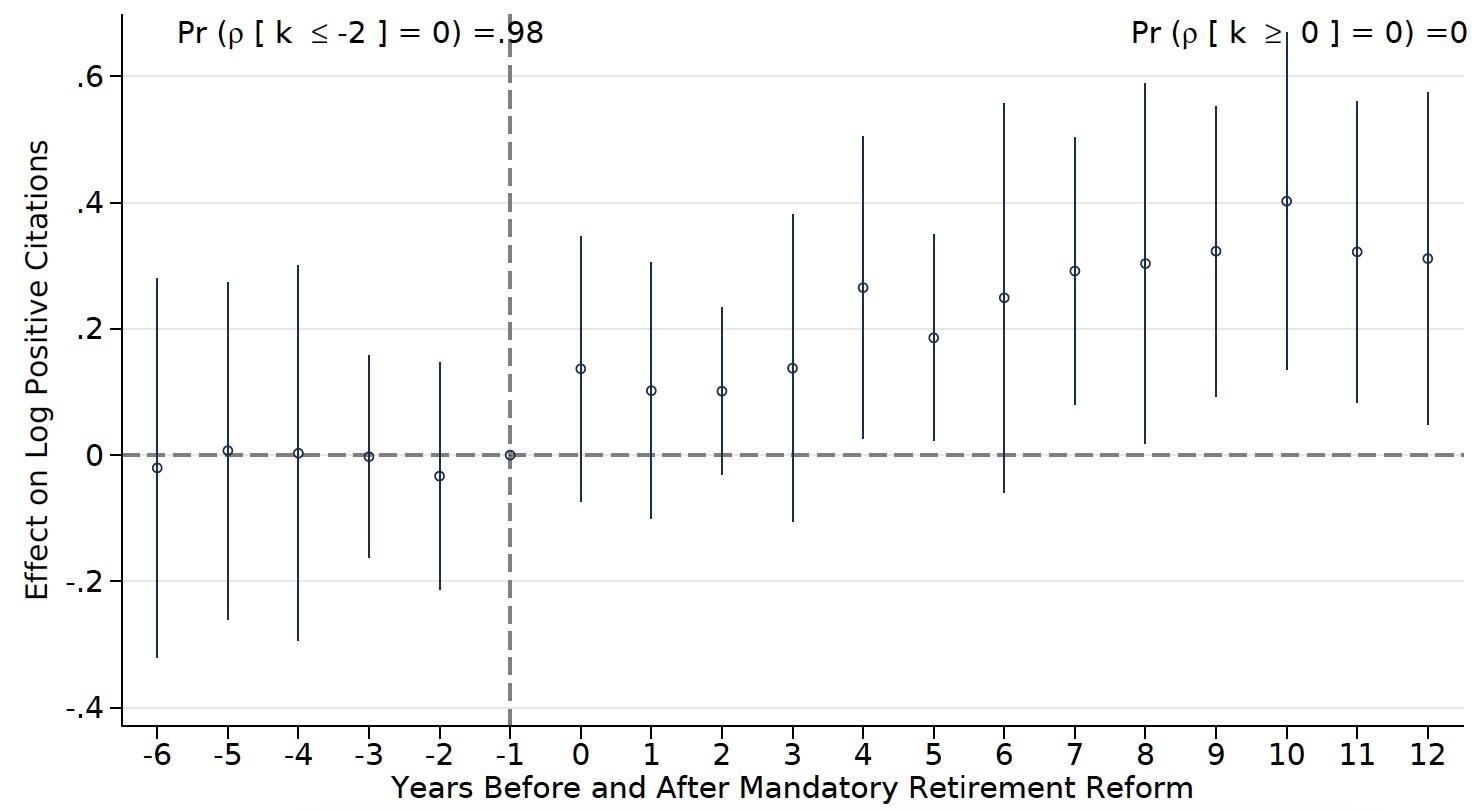All good things must come to an end, including our careers (Ichino et al. 2007). In the case of judges, that end can be delayed perhaps too long, as we saw in 2020 with the disruptive and untimely death of Justice Ruth Bader Ginsburg and as documented in an increasing number of articles about the problem of extreme old age (Lat 2011, Goldstein 2011, Kase 2017) and even dementia (ProPublica 2011) in the federal courts.
What policies can or should be introduced to address the issue of old age in the judiciary? In response to such concerns, many US states have introduced mandatory retirement rules for judges. Thirty-three states have imposed a maximum age of 70, 72, 75, or even 90 (in Vermont). These policies tend to remove judges before they show signs of old-age dementia.
But a maximum age also tends to remove judges who are still productive in their jobs. In the current Supreme Court, there are three justices (Alito at 71, Thomas at 72, and Breyer at 82) who would have been removed by mandatory retirement at age 70. Older judges have more experience and are more familiar with the law (Posner 1996).
It could be that many of the best judges are removed by a maximum-age rule, which might outweigh any productivity benefits of removing judges past their prime. Producing evidence-based policy on this issue is important given the impact judges make on social outcomes (Dippel and Poyker 2019, Cahuc et al. 2020).
What is the overall effect of mandatory retirement on court productivity? We can exploit the policy experiments in US states to provide some empirical evidence on this question. In recent research (Ash and MacLeod 2020), we measure the change in court performance before and after the introduction of mandatory retirement in the 14 states that introduced such a reform in 1947–1994. We measure productivity as the volume of work done and the legal influence of that work.
The main result is illustrated in Figure 1. Productivity increases by more than 25% after the introduction of mandatory retirement. Hence, the evidence suggests that removing the older, less productive judges outweighs the loss from removing the most experienced judges.
Figure 1 Effect of mandatory retirement on productivity in state supreme courts
This finding is not that surprising in light of another clear trend we can see in our data – as shown in Figure 2, older judges are less productive than younger judges. While there is an increase in productivity in the early years, starting in the late 50s judges become about 1% less productive with each year of ageing. Thus, the retirement reform increases court productivity by replacing the oldest incumbent judges with new younger judges.
Figure 2 Change in judge productivity over the lifespan
To better understand how these results connect, we note that the reforms reduce the average age of the oldest judges by about five years. Multiplying that by the predicted effect of ageing on productivity, we would expect at most an 8% increase in court productivity due to the direct effect of the reforms on the age distribution. Yet the observed change is 25%, about four times larger. These results point to a quantitatively important team effect of ageing, in which the presence of older judges slows down the pace of work on the court.
These findings can inform the debate about policy responses to old age in the federal judiciary, where imposing mandatory retirement is probably unconstitutional under Article III Section 1 (federal judges “shall hold their offices during good behavior”). The evidence suggests that the use of senior status, while helpful in reducing the workload of older judges, might not be enough to properly address the issue of judicial old age. Policymakers seeking empirical support for federal reforms, including potentially a constitutional amendment, could look to this study for help.
More generally, these results may be useful to leaders seeking to design better retirement policies for high-skill jobs, especially in an era of an ageing workforce (Carta et al. 2021). Dementia, in particular, is a problem for older workers and the firms that employ those workers (Bloom et al. 2021).
Though we have used the change in mandatory retirement rules to estimate these effects, it does not imply that mandatory retirement is necessarily the optimal rule. That depends on many factors, including the counterfactual occupations for both the potential retirees and new judges.
Thus, the judiciary provides a natural laboratory for learning about productivity in professional workplaces. Researching, deciding, and justifying the law is a high-skilled constellation of tasks requiring expertise and professionalism, comparable in technicality to those undertaken by physicians and scientists. Moreover, judges work alongside peer judges and supervise teams of clerks, meaning the job entails a significant social and managerial component.
Unlike the comparable private-sector occupations, however, with judges, we can observe work productivity through complete databases of their decisions and associated written opinions. In our study, we measure productivity as legal influence – the number of times a judge is cited (positively) by future judges in a given year (Choi et al. 2010).
The changes in productivity due to the reforms or ageing hold for a variety of alternative measures, including those focusing more on quality and those focusing more on quantity. The mandatory-retirement analysis adjusts for any time-invariant state-level factors, as well as nationwide trends in judge productivity. The lifespan productivity effect is relative to other judges on the same court at the same time, and therefore holds constant any factors affecting all judges.
We can show that neither the reform effect nor the ageing effect is driven by the types of cases that judges review, by differences in judge experience on the court, by the quality of clerks, or by selective attrition.
References
Ash, E, and W Bentley MacLeod (2020), “Mandatory retirement for judges improved performance on US state supreme courts”, NBER Working Paper w28025.
Bloom, D, S Chen, N Counts, R Han, S Malik, A Nandi, B Seligman and D Vigo (2021), “Addressing Alzheimer’s disease and related dementias to realise the promise of the UN’s ‘Decade of Healthy Ageing’”, VoxEU.org, 26 March.
Cahuc, P, S Carcillo, B Patault and F Moreau (2020), “Judge bias in labour courts and firm performance”, VoxEU.org, 8 November.
Carta, F, F D’Amuri and T M von Wachter (2021), “Workforce ageing, pension reforms, and firms’ outcomes”, VoxEU.org, 16 March.
Choi, S J, G Mitu Gulati and E A Posner (2010), “Professionals or politicians: The uncertain empirical case for an elected rather than appointed judiciary”, The Journal of Law, Economics, and Organization 26(2): 290–336.
Dippel, C, and M Poyker (2019), “The impact of judicial elections on criminal sentencing”, VoxEU.org, 26 June.
Goldstein, J (2011), “The oldest bench ever”, Slate.com, 18 January.
Ichino, A, G Schwerdt, R Winter-Ebmer and J Zweimüller (2007), “Too old to work, too young to retire?” VoxEU.org, 8 November.
Kase, A (2017), “When is a judge too old to judge?”, Vice.com, 21 July.
Lat, D (2011), “What is to be done about super-old judges?”, AboveTheLaw.com, 18 January.
Posner, R (1996), Aging and old age, Chicago: University of Chicago Press.
ProPublica (2011), "Life Tenure for Federal Judges Raises Issues of Senility, Dementia", 18 January.





